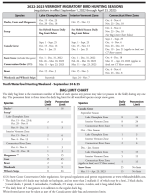2022 Duck Population Numbers | 2022-2023 Waterfowl Season (ducks.org)
Looks like the late wet conditions didn't really help as much as I hoped for. Wow, poor pintails. What is going on? So maybe someone (hey Brad!) can help me out. Have seasons/limits already been set? Going back as long as I can remember seasons were set in late summer after breeding surveys were completed. But I believe that system changed a few years ago and I'm unclear as to the new season setting process timeline. Can anyone clear this up? Thanks.
Eric
Looks like the late wet conditions didn't really help as much as I hoped for. Wow, poor pintails. What is going on? So maybe someone (hey Brad!) can help me out. Have seasons/limits already been set? Going back as long as I can remember seasons were set in late summer after breeding surveys were completed. But I believe that system changed a few years ago and I'm unclear as to the new season setting process timeline. Can anyone clear this up? Thanks.
Eric
Last edited:


